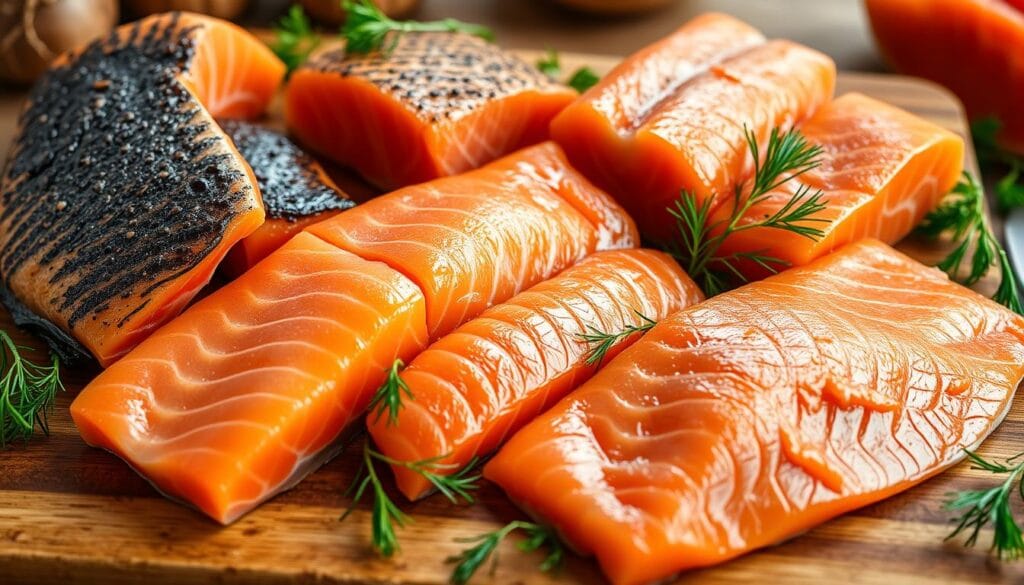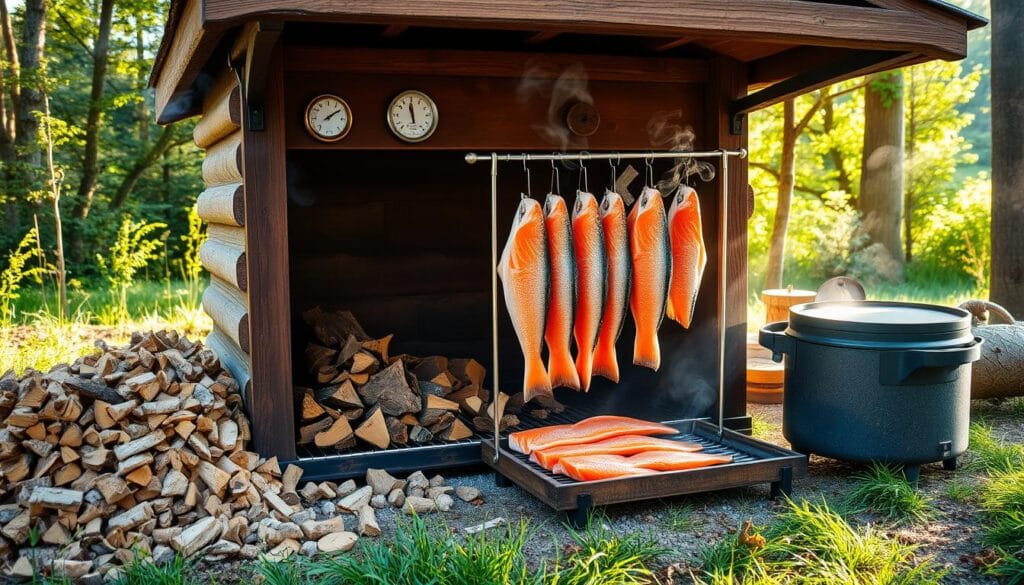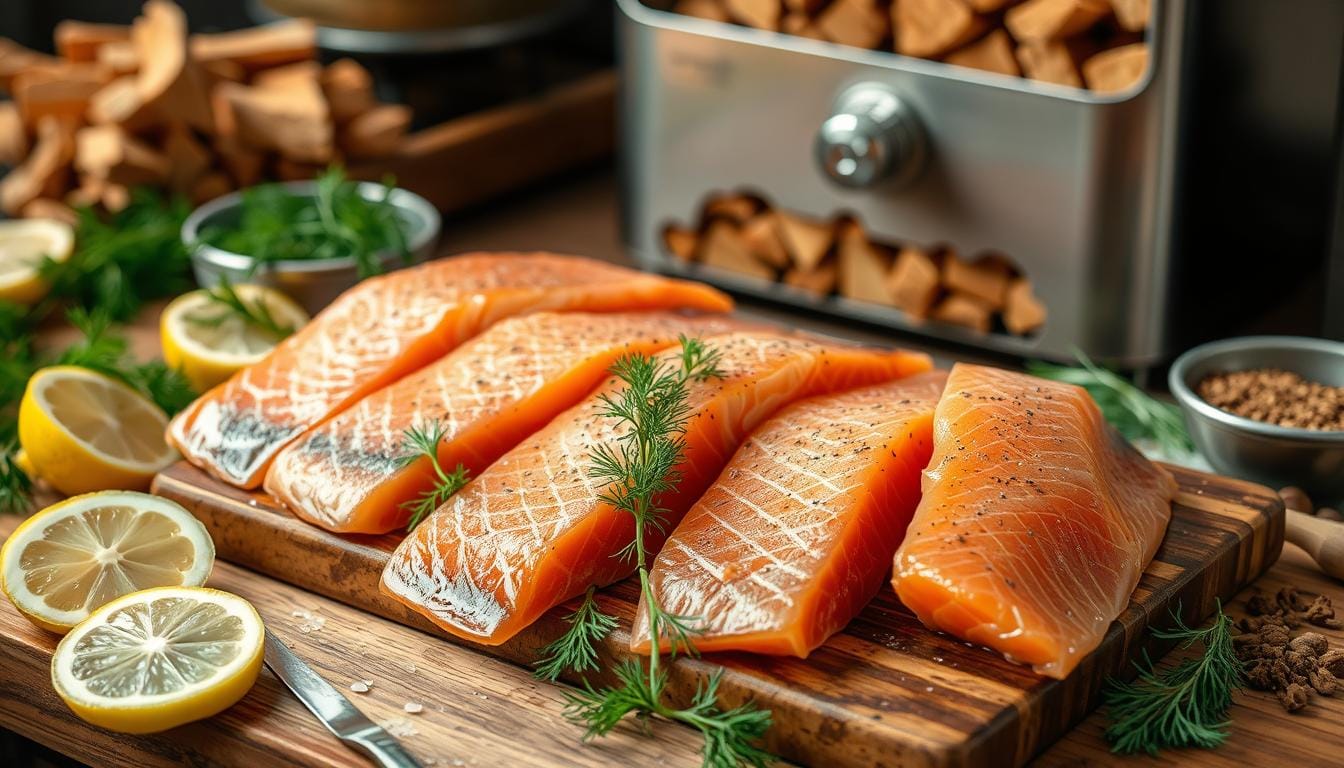The smell of smoked salmon reminds me of my grandmother’s kitchen. There, the soft smoke and deep flavors turned a simple fish into a work of art. Learning how long to smoke salmon is a delicate balance of time, temperature, and skill.
For a 2 to 2.5-pound salmon filet, you’ll need about 1 hour and 10 minutes of smoking. The secret to great smoked salmon is keeping an eye on the internal temperature. It should hit 145°F for both safety and flavor.
The time it takes to smoke salmon can change based on a few things. The size of the filet, the type of salmon, and your smoker all play a part. Smaller fish like Coho or Sockeye cook quicker than bigger ones like King Salmon. So, timing is everything to get that perfect smoky flavor.
Key Takeaways
- Typical salmon smoking duration is 1 hour and 10 minutes
- Target internal temperature should be 145°F
- Smoking time varies with salmon type and filet size
- Low temperature (225°F) ensures optimal smoking results
- Different salmon varieties require adjusted smoking times
Understanding Different Types of Salmon for Smoking
Choosing the right salmon is key for great smoked salmon. Not all salmon is the same for smoking. Knowing the differences can make your dish taste amazing.
Farm-Raised vs. Wild-Caught Salmon
You’ll find two main types of salmon: farm-raised and wild-caught. Each has its own traits for smoking:
- Farm-raised Atlantic salmon has more fat, making it easier to smoke
- Wild-caught salmon is leaner and needs careful smoking
Best Salmon Varieties for Smoking
| Salmon Variety | Fat Content | Flavor Profile |
|---|---|---|
| King Salmon (Chinook) | Highest | Rich, buttery texture |
| Sockeye Salmon | Medium | Firm, intense flavor |
| Coho Salmon | Lower | Delicate, mild taste |
Selecting Fresh Salmon
Fresh salmon is essential for top-notch smoked salmon. Here’s what to look for:
- Bright, vibrant color without discoloration
- Firm flesh that springs back when touched
- Clean, ocean-like smell without any strong fishy odor
“The quality of your salmon determines the success of your smoking process.” – Professional Seafood Chef

By knowing about salmon types and how to pick them, you’ll make smoked salmon that wows everyone.
Essential Equipment and Tools for Smoking Salmon
To master fish smoking, you need the right tools. Start by picking the perfect equipment for delicious results. Knowing the essential gear is key to turning simple salmon into a culinary masterpiece.

- Digital meat thermometer
- Quality smoker
- Wood chips
- Fish baskets
- Cooling racks
- Brine containers
Different smokers have their own benefits for seafood smoking. Let’s look at the main types:
| Smoker Type | Pros | Best For |
|---|---|---|
| Electric Smoker | Consistent temperature | Beginners |
| Pellet Smoker | Easy temperature control | Advanced home cooks |
| Charcoal Smoker | Authentic smoky flavor | Traditional smoking enthusiasts |
For fish smoking, use fruit woods like cherry and apple. They add a sweet taste that goes well with salmon.
Pro tip: Soak wood chips for at least 30 minutes before smoking to ensure consistent smoke production.
A reliable digital meat thermometer is a must. It lets you check the salmon’s internal temperature. This ensures it’s safe and cooked just right every time.
Preparing Your Salmon Before Smoking
Learning how to cure salmon is key to making great smoked fish. The prep work is the first step to a dish that will wow seafood lovers.
Removing Pin Bones and Scaling
Cleaning your salmon is a must before smoking. Use needle-nose pliers to take out pin bones for a smooth texture. Wild-caught salmon needs scaling:
- Rinse the salmon under cold water
- Hold the fish firmly by the tail
- Scrape against the grain with a fish scaler or the back of a knife
- Rinse again to remove loose scales
Trimming and Portioning
How you cut your salmon matters a lot. Cut it into pieces about 1 inch thick. Pro tip: Make sure all pieces are even to smoke evenly and avoid overcooking.
Creating the Perfect Pellicle
The pellicle is a protein layer that helps smoke stick to the fish. To get it right:
- Pat the salmon dry with paper towels
- Place fish on a rack in the refrigerator
- Let it air-dry for 1-2 hours
- The surface should feel slightly tacky
“A well-developed pellicle is the secret to beautifully smoked salmon with rich, even flavor.” – Professional Chef
By carefully following these steps, you’ll turn a regular fish into a gourmet smoked treat. It will taste like it was made the traditional way.
How Long Should You Smoke Salmon For?
Knowing how long to smoke salmon is key to making it just right. The time needed depends on the fillet size, thickness, and how done you like it.
- Typical salmon smoking time ranges from 2 to 3 hours
- Optimal smoking temperature sits between 165°F and 225°F
- Internal salmon temperature should reach 130°F to 140°F
The smoking time can change based on your situation. A good starting point is:
| Salmon Weight | Smoking Duration | Temperature |
|---|---|---|
| 1-2 pound fillet | 1-1.5 hours | 185°F |
| 3-4 pound fillet | 2-3 hours | 225°F |
Pro tip: Always use an internal meat thermometer to ensure your salmon reaches the safe temperature of 145°F, rather than relying solely on time.
“Patience is key when smoking salmon – rush the process, and you’ll compromise flavor and texture.” – Culinary Experts
Remember, thicker fillets need more time. If your fillet is skinless, use a light oil to prevent sticking.
Temperature Control and Smoking Techniques
Mastering salmon smoking needs precise temperature control and smart techniques. It’s more than just putting salmon in a smoker. Knowing the right seafood smoking guidelines can make a big difference in your cooking.
Smoking salmon requires watching the heat and technique closely. Experts say temperature control is key to making great smoked fish.
Optimal Smoking Temperature Range
The best temperature for smoking salmon is between 130°F to 150°F. At these temperatures, you get:
- Consistent protein texture
- Deep flavor penetration
- Gradual moisture retention
Wood Selection for Smoking
Your choice of wood greatly affects the flavor. Fruit woods like apple and cherry add a sweet, mild taste that goes well with salmon.
| Wood Type | Flavor Profile | Intensity |
|---|---|---|
| Apple Wood | Sweet, Mild | Low |
| Cherry Wood | Fruity, Subtle | Medium |
| Maple Wood | Smooth, Gentle | Low |
Managing Heat Distribution
Even cooking is key. Here’s how to keep temperatures steady:
- Rotate salmon pieces midway through smoking
- Use a water pan to stabilize temperature
- Monitor smoker’s internal environment
*”Temperature control is 90% of successful salmon smoking.”*
With these tips, you’ll go from beginner to pro at salmon smoking. You’ll get delicious results every time.
Simple Seasoning and Dry Brine Method
Learning how to cure salmon turns a regular fish into a tasty smoked treat. The dry brine method is easy and powerful. It makes your smoked fish recipes even better with little effort.
Your dry brine mix should have:
- 2 tablespoons brown sugar
- 1 tablespoon kosher salt
- 1 teaspoon fresh dill, chopped
- 1/8 teaspoon ground black pepper
- 1 teaspoon minced garlic
The brining process does a lot for salmon. Salt keeps moisture in and adds deep flavors. You should brine for 6 to 8 hours. Thinner salmon needs less time.
“Doubling the rub quantities can create a flavor profile reminiscent of salmon candy” – Professional Smokers’ Tip
Make sure to cover the salmon evenly with dry brine. After brining, dry the fish with a paper towel. This step seasons the salmon and helps create a pellicle. The pellicle lets smoke stick to the fish during cooking.
Pro tip: Use Dijon mustard as a base before adding your dry brine mix. This small change can make your smoked fish recipes taste like they were made by a pro.
Signs of Properly Smoked Salmon
Learning to smoke salmon well means paying close attention to certain signs. These signs show your salmon is ready. By knowing these signs, you’ll improve your cooking skills.
Visual Indicators of Quality
A good smoked salmon looks a certain way. Look for these signs:
- Glossy, reddish-orange exterior
- Smooth, slightly translucent surface
- White protein droplets (albumin) emerging on the surface
- Uniform color throughout the fillet
Temperature Testing Techniques
Getting the right temperature is key in smoking salmon. Use a meat thermometer to check the salmon’s internal temperature. It should be 145°F at its thickest part. Make sure the probe is in the center, away from bones or skin.
“The key to perfect smoked salmon is precision in temperature and timing.” – Culinary Expert
Texture Assessment
The texture of smoked salmon tells you how well it’s cooked. A good smoked salmon should be:
- Flaky, yet moist texture
- Firm but tender consistency
- Easily separates with a fork
- No rubbery or dry characteristics
Pro tip: Let your salmon rest for a few minutes after smoking. This helps the juices spread, keeping it flavorful and moist.
Storage and Preservation Methods
After you’ve smoked your salmon, it’s important to store it right. This keeps its flavor and quality top-notch. Seafood smoking guidelines suggest certain ways to preserve your salmon.
Handling your smoked salmon with care is key to keeping it fresh longer. Here are the main storage tips:
- Refrigeration: Store smoked salmon in an airtight container
- Vacuum sealing helps extend preservation time
- Keep salmon at consistent cool temperatures
Here are the details for refrigerating your smoked salmon:
| Storage Method | Duration | Quality Preservation |
|---|---|---|
| Refrigerated (Wrapped Tightly) | 7-10 days | Excellent |
| Vacuum Sealed | Up to 2 months | Very Good |
| Frozen | Up to 3 months | Good |
Pro tip: Always use clean utensils when handling smoked salmon. Avoid sudden changes in temperature to keep its texture and flavor.
“Proper storage is the final step in transforming your smoked salmon from a good dish to an extraordinary culinary experience.”
When freezing your smoked salmon, wrap it tightly in moisture-proof paper or vacuum-seal it. This prevents freezer burn. Thaw it slowly in the fridge to keep its texture and flavor.
Common Smoking Mistakes to Avoid
Learning how to smoke fish well means knowing what can go wrong. Both new and seasoned smokers face problems that can ruin the taste and texture of their smoked salmon.
Here are the most critical mistakes to avoid when smoking salmon:
- Neglecting Pellicle Formation Not drying the salmon before smoking means the smoke won’t stick well. Make sure to air dry the salmon for 1-2 hours first. This helps create a good pellicle.
- Incorrect Temperature Control Keeping the temperature steady is key. If it’s not, your salmon might dry out. Try to keep it between 160°F-180°F during smoking to keep it tender.
- Over-Smoking the Fish Too much smoke can mask the salmon’s flavor. Smoke it for 2-4 hours or until it reaches 145°F inside.
“The key to exceptional smoked salmon is patience and precision.” – Professional Seafood Chef
Other mistakes include not brining enough, using the wrong wood chips, and not checking the fish’s temperature. A simple brine of 1/3 cup kosher salt and 1 cup brown sugar per quart of water can help avoid these problems.
Knowing these common mistakes will help you make delicious smoked salmon every time. It’s all about using the right fish smoking methods.
Conclusion
Smoking salmon is more than just cooking. It’s an art that needs precision, patience, and passion. You’ve learned how long to smoke salmon, and each step is crucial. From picking the right salmon to keeping an eye on temperatures, your recipes will get better with practice.
Remember, food safety is key in smoking salmon. Always keep your smoked salmon in the fridge at 40°F or below. Opened salmon should be eaten within three to five days. If stored right, it can last up to a week, giving you plenty of time to enjoy it.
The secret to great smoked salmon is knowing about temperature, technique, and timing. Whether you use hot or cold smoking, keeping the internal temperature around 140°F is important. Try different wood chips, brining methods, and smoking times to make your own unique recipe.
Your salmon smoking journey is just starting. Be open to learning, trust your gut, and feel free to try new things. With each try, you’ll get better and make smoked salmon that will wow everyone.
FAQs
How long does it typically take to smoke salmon?
Smoking salmon takes 2 to 4 hours. This depends on the fish’s size and thickness. Keep the temperature steady between 175°F and 225°F. Make sure the fish reaches 145°F for safety and keeps it moist and tasty.
What type of salmon is best for smoking?
King Salmon and Sockeye Salmon are top choices for smoking. They have a lot of fat and taste great. Wild-caught salmon often tastes better than farm-raised, but both can be delicious if smoked right.
Do I need to brine salmon before smoking?
Yes, brining is a must. It keeps the fish moist, adds flavor, and helps the smoke stick better. You can use a wet or dry brine. Most recipes suggest a salt-based solution or a dry rub with salt and seasonings.
What wood is best for smoking salmon?
Alder wood is the classic choice for salmon. It gives a mild, sweet flavor. Apple wood adds a sweeter taste, while cherry wood gives a fruity note.
How can I tell when my smoked salmon is done?
Check for an internal temperature of 145°F, a golden color, and a firm but moist texture. The fish should flake easily but not be dry. You’ll see white protein on the surface, which is normal.
How long can I store smoked salmon?
Smoked salmon lasts 1-2 weeks in the fridge in an airtight container. Vacuum-sealed, it can last up to 2-3 weeks. You can freeze it for up to 3 months to keep it fresh.
What temperature should I smoke salmon at?
Smoke salmon at 175°F to 225°F. Lower temperatures around 175°F make the flavor more delicate and prevent drying. Higher temperatures near 225°F shorten the smoking time.
Can I smoke salmon without a dedicated smoker?
Yes, you can smoke salmon in a charcoal grill, a gas grill setup, or even your oven with wood chips. Just keep the temperature low and consistent to smoke the salmon gently.


1 thought on “how long should you smoke salmon for?”